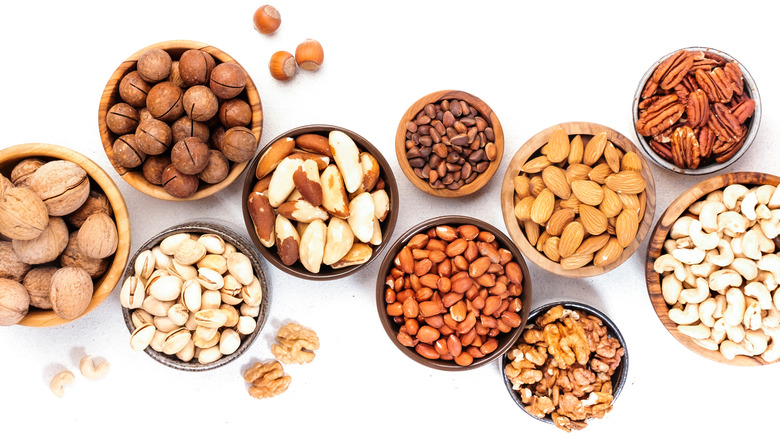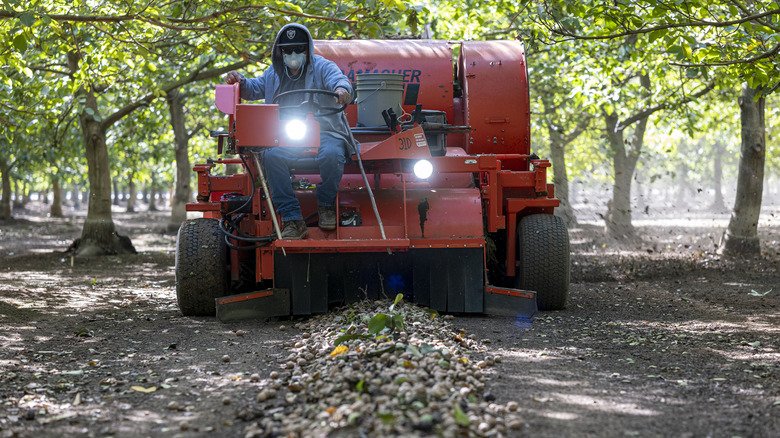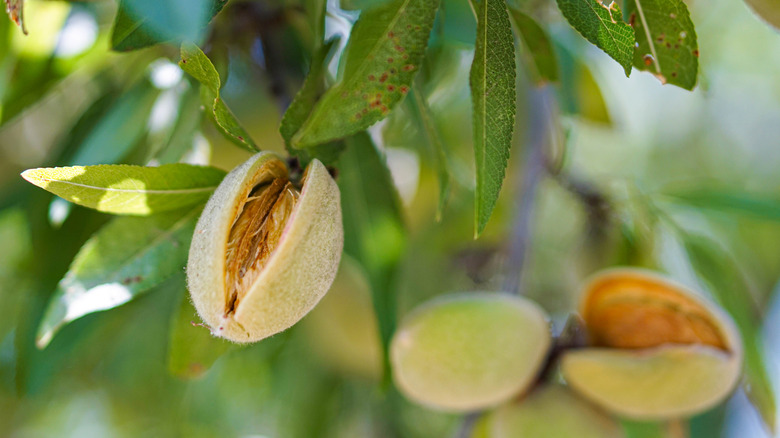Which U.S. State Produces The Most Nuts?
The United States of America is nuts for nuts, and it's easy to see why. Nuts are good for your health, and there are some amazingly nutty recipes out there. Strangely, though, a lot of "nuts" aren't actually nuts.
As explained by Encyclopedia Britannica, true nuts are hard, dry fruits with a single seed that don't split open once matured, like acorns, chestnuts, and hazelnuts. However, many other oily, shelled seeds qualify, too, at least, when it comes to culinary uses. This includes capsules like the Brazil nut, legumes like the peanut, and drupes like the almond, pistachio, and walnut.
Per the U.S. Forest Service, there are a handful of nuts native to North America, like acorns, black walnuts, and pine nuts. Such nuts have historically been eaten by indigenous peoples, and that culinary practice endures to the present day. Plus, new nuts have been transplanted stateside in relatively modern times.
According to Nut Health, English walnuts were brought to Southern California by the 1800s. Almonds, on the other hand, fared better in California's drier inland areas. Also during the 19th century, Australian macadamias were established in Hawaii, and hazelnuts were introduced to Oregon. In the 1900s, pistachios took root in New Mexico. The 20th century also saw the invention of nutty American dishes such as pecan pie, trail mix, and Walldorf salad. So, how does the 21st-century U.S. nut industry look today?
The Golden State is No. 1
Currently, the U.S. nut industry is concentrated in one particular place: California. As explained by the Agricultural Marketing Resource Center, the Golden State leads the nation in tree-nut production, cultivating millions of tons each year. The vast majority of annual nut growth comes from Californian orchards, and this is especially true for walnuts, pistachios, and pecans.
California loves its nutty crops so much that it has an official state nut. Actually, it's got four of them! Although, not all of them are botanically considered true nuts (but that's beside the culinary point). As reported by the Los Angeles Times back in 2017, then-Governor Jerry Brown signed a declaration into law designating the almond, pecan, pistachio, and walnut (all belonging to the drupe family of fruits) as state symbols. The initial push came from a fourth-grade class of kids, who wanted the California almond and its $4-billion industry to rival Arkansas' and Texas' pecan, as well as Missouri's tree nut. Others joined in, pushing for walnuts, pistachios, and pecans to share the spotlight. Even with nuts contributing to a recent California drought, lawmakers agreed and made them official.
The future of California nuts
The U.S. nut industry faces both hardships and opportunities in the early 2020s. Globally, the country is the second biggest grower of nuts, generating nearly $10 billion in revenue a year while exporting most of its bounty, according to Choices Magazine (Australia, Chile, Iran, and Turkey are other top nut-growing countries). California accounts for roughly 95% of that U.S. production value. Yet, Arizona, Georgia, New Mexico, Oklahoma, Oregon, Texas, and Washington contribute somewhat, also. Thankfully, more and more Americans are turning to nuts lately, as trade groups, marketing initiatives, and government programs push healthy eating. On the other hand, though, labor shortages, trade disputes, and water scarcity all stand in the way of successful agriculture for nuts.
Regarding California specifically, Growing Produce reports that the outlook is sort of a mixed bag. A majority of nut farmers were planning on increasing production in 2022, but returns on crops like almonds and walnuts have fallen in recent years. Meanwhile, the pistachio, once a southern crop, is now being eyed for growth in Northern California. Still, steep input costs and government regulations make it harder to turn a profit. As such, corners get cut during cultivation and selling prices increase. On a more positive note, innovation in farming techniques can also help with these challenges. California is so far ahead of everywhere else in nut production, it seems unlikely the Golden State will fall behind anytime soon. Still, bumper crops aren't grown by resting on one's laurels.


